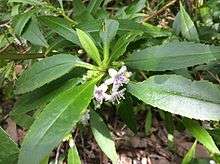Myoporum tetrandrum
Myoporum tetrandrum, commonly known as slender myoporum or boobialla[1] is a plant in the figwort family, Scrophulariaceae. It is an erect and spreading shrub endemic to the south-west of Western Australia, common in moist areas and like most of the other members of its genus has bell shaped, star-like white flowers in the leaf axils.
| Slender myoporum | |
|---|---|
 | |
| Myoporum tetrandrum in the Porongurup National Park | |
| Scientific classification | |
| Kingdom: | Plantae |
| Clade: | Tracheophytes |
| Clade: | Angiosperms |
| Clade: | Eudicots |
| Clade: | Asterids |
| Order: | Lamiales |
| Family: | Scrophulariaceae |
| Genus: | Myoporum |
| Species: | M. tetrandrum |
| Binomial name | |
| Myoporum tetrandrum | |
| Synonyms[1] | |
Description
Myoporum tetrandrum is a shrub sometimes growing to a height of 3 metres (10 ft) with young branches that are glabrous and rather flattened. Its leaves are arranged alternately and are usually 32–80 millimetres (1–3 in) long, 3–10 millimetres (0.1–0.4 in) wide, elliptic in shape and usually have small teeth or serrations in approximately the outer half. The leaves are a similar deep green colour on both surfaces and the lower surface has a distinct mid-vein.[2][3]
The flowers are borne in groups of about 5 to 7 (sometimes more or fewer) on a stalk 4–7.5 millimetres (0.2–0.3 in) long. The flowers have 5 egg-shaped sepals and 5 petals, joined at their bases to form a tube. The petals are white with purple spots on the lobes of the tube and the upper part of the tube. The tube is about 2.5–4 millimetres (0.1–0.2 in) long and the lobes are slightly shorter than the tube. The inside of the tube and part of the lobes are hairy. There are 4 stamens which extend beyond the petals. Flowers are often present from May to January and the fruits that follow are green and fleshy at first but dry when mature.[2][3]
Taxonomy and naming
Myoporum tetrandrum was first formally described by Jacques Labillardière in 1805 as Pogonia tetrandra.[4] In 1923, Karel Domin changed the name to Myoporum tetrandrum, describing the change in Vestnik Kralovske Ceske Spolecnosti Nauk, Trida Matematiko-Prirodevedecke.[1] The specific epithet (tetrandra) is derived from the ancient Greek tetra- (τετρα-), meaning "four" and anēr, genitive andros (ἀνήρ, genitive ἀνδρός), meaning "male" or in this case "stamen".[5]
Distribution and habitat
Slender myoporum occurs in Western Australia in near-coastal areas between the Stirling Range and Israelite Bay[2] in the Esperance Plains, Jarrah Forest, Mallee and Warren biogeographic regions.[6] It grows in sandy soil, usually in damp places like floodplains and along streams, often in association with Melaleuca species.[2][7]
Ecology
Myoporum tetrandrum contains a high percentage (up to 0.5%) of sesquiterpene essential oil making the plant toxic to livestock which suffer liver damage.[8]
Use in horticulture
Slender myoporum is a hardy plant in well-drained soil in full sun and is most easily propagated from cuttings.[9] It grows well in Portugal and is naturalised there.[10]
References
- "Myoporum tetrandrum". APNI. Retrieved 29 November 2015.
- Chinnock, R.J. (Bob) (2007). Eremophila and allied genera : a monograph of the plant family Myoporaceae (1st ed.). Dural, NSW: Rosenberg. pp. 152–155. ISBN 9781877058165.
- Archer, William. "Myoporum tetrandrum". Esperance Wildflowers. Retrieved 29 November 2015.
- "Pogonia tetrandra". APNI. Retrieved 29 November 2015.
- Backer, C.A. (1936). Verklarend woordenboek der wetenschappelijke namen van de in Nederland en Nederlandsch-Indië in het wild groeiende en in tuinen en parken gekweekte varens en hoogere planten (Edition Nicoline van der Sijs).
- "Myoporum tetrandrum (Labill.) Domin". FloraBase. Western Australian Government Department of Parks and Wildlife.
- Paczkowska, Grazyna; Chapman, Alex R. (2000). The Western Australian flora : a descriptive catalogue. Perth: Wildflower Society of Western Australia. p. 344. ISBN 0646402439.
- Allen, JG; Seawright, AA; Hrdlicka, J (June 1978). "The toxicity of myoporum tetrandrum (Boobialla) and myoporaceous furanoid essential oils for ruminants". Australian Veterinary Journal. 54 (6): 287–92. doi:10.1111/j.1751-0813.1978.tb02461.x. PMID 687296.
- Wrigley, John W.; Fagg, Murray (1983). Australian native plants : a manual for their propagation, cultivation and use in landscaping (2nd ed.). Sydney: Collins. p. 272. ISBN 0002165759.
- "Myoporum tetrandrum". Plants for a Future. Retrieved 29 November 2015.